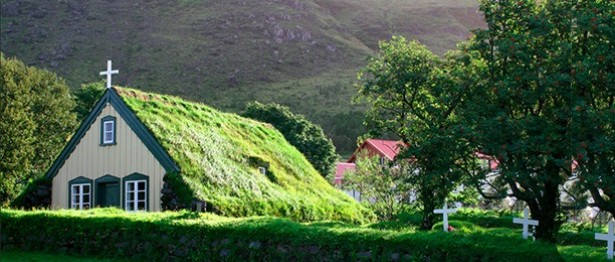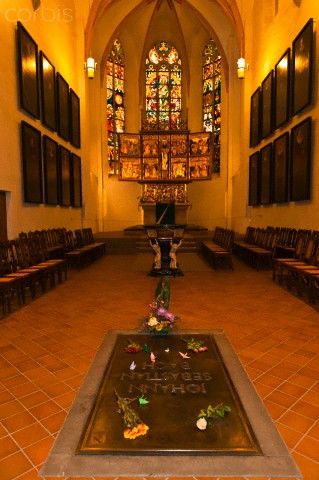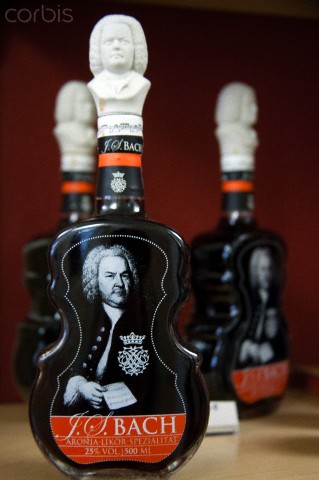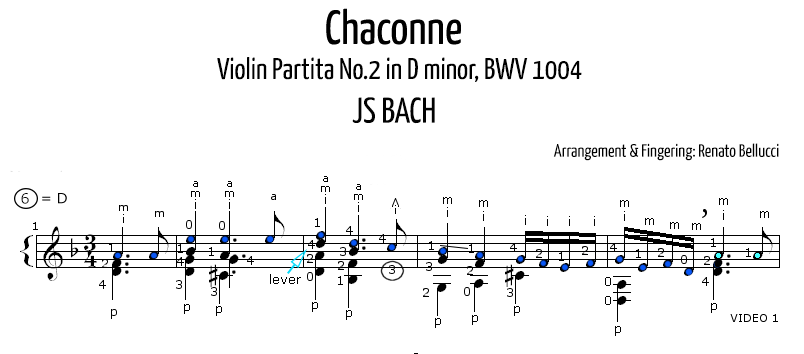
Bach, "Chaconne BWV 1004"
Transcription and Fingering: Renato Bellucci
FACTS
1-After studying Bach's life for over 30 years, I arrived at the following conclusion: "As a consequence of the Reformation, Bach tried to replace the absence of the Catholic Sacraments elevating his music to the point where the souls attending Sunday celebrations would not miss the Eucharist. The intention elevated his music to such unimaginable levels... naturally, the Holy Sacraments can never be replaced by anything human."
2-By the age of ten and in less than a year both his parents die. Coming from the largest musical family in Germany and thanks to the immense exposure to music in family gatherings, he decided to win over death by becoming a creator.
3-His son brought music of Vivaldi from Amsterdam. Vivaldi had grand openings but poor continuations. Bach took the idea and being so constant only made his music more interesting as it advanced.
4-D is the most resonant key and Bach knew it. That is why he used this key to write his most epic works
5-After 1 month in prison, moved to Cothen which he later described as his happiest years. In Cothen he becomes the first composer ever to write music in all possible keys: 24, the WTC (Well Tempered Clavier). I believe some of the keys he played were only played by him on that occasion.
6-Schumann, Beethoven, Mozart played the 24 Preludes and Fugues of the WTC EVER DAY
7-Moved to Leipzig at 38 Where he remained until the end. Was the music director of the whole city and this was an important city.
8-1727 writes the Passion according to St Matthew considered his #1 masterpiece.
9-"Our profession in this world is to learn how to die"
10-The mass in B minor is from his final years and is monumental.
11-Bach dies while composing The Art of Fugue. The theme of the Fugue was based on his name BACH -Bb A C B-
____________________________________________________________________
LIFE
All of Bach´s Divine genius and musical mastery are found in the Chaconne and "no other composer has ever composed such a gigantic masterpiece". It is only logic to venture in saying that no other composer will ever equal it. "It is a triumph of spirit over matter"
Due to the harmonic rhythm, the tempo must be fairly slow. "Segovia's transcription and performance is superb, with the guitar allowing for a deep bass, one octave lower than written, so that the music is enhanced in its majesty". The performer needs to be aware of the transformations of the basic four-note subject (D, C#, Bb, A). Not only does the subject repeat almost relentlessly, but Bach restated and transformed it in many versions, in sixteenth and eighth notes, and the performer should be aware that these segments divide the music into basic statements. This approach also helps the performer learn the piece since it allows for many "micro-pieces" to be played one after the other.
______________________________________________________________________
INTRODUCTION:
San Bernardino, April 7, 2015
It has taken me the best part of 7 years to complete the offering of Bach Chaconne in Dm to my students. I was not contemplating the gigantic enterprise I was about to embark on and only today I am happy I did not. I would have probably never started if I had known all that was going to happen from the day I started in January 2007 and the day I uploaded the last staff and video in October 2014. You will even see my style in preparing the staffs and scores change as the years passed and I got a hold of different music notation software and expertise.
Only these past few days in April 2015 I decided to format and even out the staffs and scores but only partially because I do not want the work to loose its epic background story. Very much in the Bachian style, I want to offer this accomplishment to God and do it the way the great German Master did with a sober and very direct S.D.G. Soli Deo Gloria, To God All the Glory.
Bach is the real reason I decided to remain an interpreter and not feel the urge to become a composer. I had to be at least partly responsible to keep his work alive. In Bach's work we find the highest and most precious virtues of a human being: Faith, work, love and passion illuminated by the greatest genius who knew exactly where he was coming from and where he wanted to go: Heaven. I was recently hearing a lecture and I came to find out that Bach music is responsible for the conversion of many agnostics and atheists. In the words of one of these converts: "When you discover Bach's St. Matthew's Passion you come to the conclusion that there must be a God".
Bach said that the the only valid reasons to do music was to "Honor God and Illuminate the Mind". (Deus Omnis Gloria or S.D.G. Soli Deo Gloria was the 3 characters inscription that crowned all his work -To God Alone the Glory-). It took 49 years and the effort of 12 countries and 23 royal patrons to gather and publish the complete corpus of Bach's surviving works.
"Bachs 's work displays perfect unity and balance of emotional subtlety and depth with an awesome, unrivaled depth of technical means and architecture by which they are achieved. Bach brings forth that height of human feelings in a way that reveals the workings of one of the supreme intellects of all time".
I personally feel blessed for belonging to the same profession as J.S.Bach. My greatest admiration for the man, was triggered by a small pocket book maestro Abel Carlevaro landed to me. It was to become the only book I read in a few hours. It was Bach's life seen through his wife's diary. It was her diary actually. That moment when you were struck by the greatness of a normal life mixed with the greatest musical genius humanity had ever known or would ever know since.. unforgettable. The greatness of a normal life, its eternal meaning.
The daily anecdotes told by Anna Magdalena simply make you a part of the man's life. The man was... A man! He was happy, at times sad, even desperate. He had a Faith, a big passion for music. He got angry and at times he was afraid...he smoked the pipe and actually wrote poems to it. Anna survived Johannes 10 years and died in a poorhouse. She never regretted her life with him. Johannes never fancied to be the greatest...he was simply one more Bach to become a musician (7 generations of Bach's had already included 50 cantors, organists and town musicians, so many Bachs had been musicians that the name was synonymous with musician). He wanted to do his job "as well as he knew how..". Wow.. what a sentence! As well as he knew how... It struck me like a vision. "That" was "all I had to do to be like the man I admired the most... To do my job as well as I knew how. This is what I had to do in order to become a Saint!"
Brahms' music is beautiful but I think that his greatest life achievement was to revive Bach' figure for all the future generations. He was quoted saying "The two greatest events of my lifetime are the founding of the German Empire and the completion of the Bach Gesellschaft's publications". We know what happened to the first, but the second is definitely the one Empire where the sun never sets.
The Well Tempered Clavier works also belong to the Cothen period along with the Inventions. Bach said that these were his happiest years. The Chaconne was the most daring work from this period and probably one of humanity's highest musical accomplishments.
Many do not know that he wrote the Chaconne when he returned from a 3 months long trip with the Emperor and arriving at home finds out that Barbara, his wife, had died and had been buried 3 days earlier. Bach sat down and only got up when the Chaconne was finished. This explains why this piece is such a monumental Masterpiece. The mother of his first 7 children was not going to walk with him from there on.
The Chaconne is a special type of continuous Theme and Variations where a somewhat short subject (normally 4 measures) is relentlessly repeated and varied. The total sixty variations are built on a descending ground bass: D, C#, Bb, A. It is a slow dance in simple triple meter (Bach's compositions were all in triple time, as a reminder of his love for The Holy Trinity), often in a minor key. It uses the rhythm of a Saraband (an antique Spanish dance) .
The piece can adapt to any player and the music allows for many fingering possibilities. Remember that. My approach to fingering, as opposed to Segovia's, was open for "discussion" and the I say: "whatever works best for you". "The Chaconne clearly represents that humans have an incredible capacity for elaboration and variation. Anyone who can speak on a topic for fifteen minutes without running out of ideas and without repeating himself will understand what an epic human landmark the Chaconne in Dm is. Its "topic", is the D, C#, Bb, A chord progression."Bach Creates upon this for nearly fifteen minutes without repeating himself and without loosing our attention!
The Chaconne is a technical piece illustrating not only the ingenuity and perfection of tools (violin/piano/guitar/orchestra), but the capacity of the human body to use them in skillful ways. This work is the most difficult piece of music of all time and on any instrument. It requires incredible musicianship as well as technical mastery of the instrument. The Chaconne is a feelingful work that explores the full range of human emotions. It is as if, in spite of economical means and technical wizardry, Bach still gets under our skins and into our hearts. "The Chaconne is the most wonderful, unfathomable pieces of music. On one stave, for a small instrument, the man writes a whole world of the deepest thoughts and most powerful feelings. -If I imagined that I could have created, even conceived the piece, I am quite certain that the excess of excitement and earth shattering experience would have driven me out of my mind." -Johannes Brahms. This gigantic piece is arguably the greatest set of variations for any instrument ever written.
The Chaconne has been transcribed on to virtually every instrument capable of retaining its rich harmony and stands on its own as a Spanish dance in slow triple time. Much of the attraction of its brooding beauty has been from the 16th century onwards. The only other variations that comes even close to its perfection are the Goldberg variations (Glenn Gould renders this masterpiece fully on the piano). Had Bach only written these two works, he would still be considered the greatest composer who ever lived. The work is often performed separate to the other dances in the Partita and consists of 31 variations. It builds up to a climax with the epicenter being the middle section in the comparative key of D major. The original score remains today in Bach's handwriting and it provides an invaluable reference to understanding the composer's musical intentions. The Chaconne as been performed and recorded by numerous musicians. Leopold Stokowsky´s orchestral arrangement is perhaps Bach´s dream come true. Being one of the few musicians who ever recorded the piece on guitar, is no doubt my dream come true. I invite you to buy my CD Chaconne (2000) here
Renato Bellucci Plays Bach "Chaconne" Aug 26-2015, Parts 1 & 2
Add to playlist
Bach Chaconne 2/2, Aug 27-2015, Parts 3 & 4
Add to playlist
One Excellent BBC Documentary on Bach
Add to playlist
It is a marvelously told story, very much in the style of the BBC. I Recommend it wholeheartedly.
Staff and Video 1
Analysis:
Very much in the German master's style, the main theme, onto which the masterwork is built, is presented at the very beginning. very much in the style of a Baroque Fugue at which style Bach was the undisputed Master. I highlighted the notes of the main theme in blue. Although 3/4 and the dotted quarter notes may indicate a strict rhythmic pattern, the truth is that the performer can unlock the tempo bringing out the subtle harmonic beauties of the piece. The two light blue notes at the end of the staff following the breathe coma, indicate the beginning of the first variation. The second A in measure 1, the third E in measure 2 and the C at the end of measure 3 are passing notes. A passing note is a non-harmonic note that happens between two notes in a scale motion and diminishes the gap between the 2 notes.
Be careful and lift the C# 9 (third Bass note from the left) perpendicularly to string 5 and with the help of the arm in order to eliminate undesirable string squeaks
Video 1
Updated: Asunción, November 15, 2011
Updated: Santa Monica, CA, January 20 & 27, 2013
Updated: Asunción, January 31, 2013
Updated: Asunción, May 23, 2014
The continuation of this masterclass is in the members area, become a member today.
 Back to Top
Back to Top






